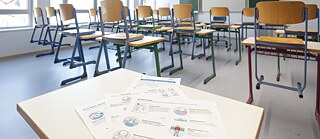Education systems in the COVID-19 era
Language teachers report on teaching during the Coronavirus pandemic in the US

The consequences of the pandemic pose an unprecedented challenge to education systems all over the world. Teachers and students have been particularly hard hit in the US, where the virus continues to spread unabated. The upcoming reorganization of the schools there will radically change teaching in America.
By Andrea Pfeil
The crisis has exposed inequalities
According to a study by the US non-profit organization Common Sense Media, four out of ten teenagers in the US say they haven’t taken part in online education regularly, if at all, since the beginning of the coronavirus crisis.
Although the survey only covers 800 students at public schools, it does reveal a trend in the US, says Alysha Holmquist Posner, a German teacher at Enumclaw High School in Washington, in response to a question about changes in her teaching due to the coronavirus crisis.
“This crisis has brought disparities to light that we might not have seen as easily before. Students with tough living situations might not have the internet access needed to maintain their lessons, or (in many cases here) they are living in a rural area with unreliable internet.” Alysha Holmquist Posner
Elementary functions of schools have gone by the board
The crisis has brought to light and exacerbated the already formidable challenges facing the US public school system. "Remote learning" cannot perform some of the vital extra-curricular functions of schools. Melanie Mello at Chandler High School in Phoenix, Arizona, concurs:
“The current crisis makes it even clearer that barriers to an equitable education have to be removed. What needs to change is the way public schools and their students are funded and equipped in order to ensure that all learners have equal access to electronic devices and a reliable wifi connection. Technology at home was already a distinguishing factor in student success (…) Many schools had less than 30% participation from their student body. Students who come from families that cannot afford computers and internet access won't have it unless it is provided to them from some outside organization. In this sense, the global health crisis has made it impossible for a large portion of my students to do any work at all.” Melanie Mello
And even if students have the necessary technical infrastructure and a family environment that enable them to participate actively in online classes, other elementary functions of face-to-face schooling have gone by the board over the past three months.
“I do not believe that remote learning will become the primary means of education in the future, as children will continue to receive most of their education in a traditional classroom setting. At least in the USA, the demands that children have a place to be while their parents work will not go away any time soon. Moreover, the social skills learned in the classroom will remain as important now as ever.” Melanie Mello.
Opportunities for new approaches after the crisis
Students need social contact in their everyday lives. Many of them find purely online interaction, e.g. on social media, insufficient. On the other hand, this crisis also holds educational opportunities that may prove especially useful for foreign language instruction.
“The global public health crisis impacted my teaching because of virtual instruction. For example, with video conferencing, I was able to present lessons with “guest speakers” live from Germany, much to my students’ delight.” Christine Conz Moll, Fleetwood Area School District in Fleetwood, Pennsylvania
Even before the coronavirus, native speakers could be invited into the classroom to talk with kids. But the crisis has increased the need for more diversity and stimuli in teaching and is giving rise to new, innovative programs, such as the German-American Virtual Exchange (GAVE) program of the German-American Partnership Program (GAPP), which normally only provides support for in-person intercultural exchanges between two partner schools.
“Unprecedented events and times are causing us to look for unprecedented opportunities. While the virtual exchange is lacking many of the amazing factors that make student exchanges so exciting and valuable, it also offers many benefits that I had not previously considered…. Furthermore, students who worried about signing on to stay at “a stranger’s home” for two weeks were happy to take the plunge and allow “the stranger” into their living room, introduced them to their family, and quickly became friends.” Heike Wrenn, Boiling Springs High School, Boiling Springs, South Carolina
One key factor in successful learning and student participation is the preparation of learning materials. The idea is to move away from exercises and worksheets towards project-oriented and interdisciplinary instruction, which opens up several approaches to learning and makes the educational objective transparent to students. Even more decisive than the learning materials, however, is supervision by the teacher, ongoing support in the learning process and feedback on completed assignments, as well as sharing thoughts on solitary or collective learning experiences. The teacher’s function becomes even more essential in a virtual learning environment, while the tasks they have to handle become more varied and student-centered.
Finding the right mix
Blended or hybrid learning is a pedagogical approach that integrates these various aspects and combines traditional classroom with virtual teaching. Students are not “left to their own devices” online. Instead, the teacher interweaves these two educational approaches to make the most of the advantages of face-to-face instruction as well as the opportunities that digital learning has to offer.
“I think that I am looking forward to a blended curriculum or an A/B schedule. I think that there is a great possibility for more positive engagement when there are lower numbers of students in the classroom and am looking forward to the other students doing work at home that will support this engagement.” Heike Wrenn
The second half of this past school year was very difficult for students and teachers and, indeed, for the entire education system in the US. It probably won’t be possible to hold traditional face-to-face classes with all the students even in the fall. So schools will need to come up with new content and, above all, methodological concepts that combine classroom learning with e-learning and give students an opportunity to acquire knowledge and skills more independently, though with guidance and support in a social environment.
“Yes, I think education has changed forever. I think this situation is allowing us to see possibilities for flipped class learning, and for new uses of technology in our classrooms. I think that the blended learning approach will be here to stay after we return to school in the fall.” Alysha Holmquist Posner.


